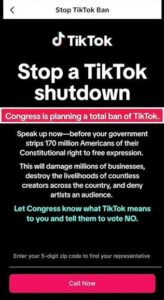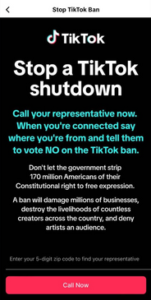Tiktok’s Digital Campaign Provides Lesson for Advocacy Campaigns
As the United States House of Representatives was mulling a bill that would force TikTok to divest its US-based business or face an outright ban, TikTok’s government affairs team put together a last-minute grassroots strategy. They deployed push notifications to the app, urging users to contact their congressional representatives.
While it sounds great on paper—mobilize the company’s massive young user base and demonstrate strength in numbers—it appears to have backfired.
As the BBC reports, “Lawmakers and their staff say that the lobbying campaign has actually worsened the concerns they have about the app and its parent company ByteDance, and strengthened their resolve to pass the legislation.”
One House staffer said that most of the callers are “really confused and are calling because ‘TikTok told me to.’”
The anti-TikTok bill passed the House with rare bipartisan support and is headed to the United States Senate.
Here are a couple key lessons for any organization doing direct advocacy on a big legislative issue:
Lesson 1: Education before mobilization
The strategy of mobilizing constituents to lobby against the legislation made sense on paper, but there were some flaws.
TikTok’s first problem was not properly educating supporters. If you’re going to turn loose ordinary citizens on the Congressional switchboard, they’re going to be put on the spot, either leaving voicemails or having live, spontaneous interactions with staffers. Your most passionate voices need to know what they’re talking about to effectively advocate for you.
That’s hard for experienced citizen-activists, and even more challenging for people for whom this is their first time contacting a rep or senator. This oversight culminated in low-quality phone calls that undermined the perception of a true groundswell of grassroots support.
Observers also noted the in-app prompts were likely aimed at teens and seemed to generate calls that were abusive, vowing self-harm, and threatening to lawmakers. Senator Thom Tillis posted a recording on X (formerly Twitter) of one such voicemail, which had over 530,000 views at the time of writing.
Lesson 2: Strategy and tactics must be aligned
The bigger issue for TikTok is their mobilization effort only underscored Congress’s fears. A key driver of the TikTok legislation is the suspicion that the company, because of its relationship with the Chinese government, may misuse the app to shape American political attitudes. It isn’t clear why someone at TikTok thought the response to this allegation was to…use the app to shape American political attitudes, but that’s what happened.
This appears to be a textbook misalignment of strategy and tactics. Demonstrating broad voter support for your political position is a critical strategy, but unleashing thousands of under-informed users on Congressional staff was the wrong way to go about it—when TikTokers called their reps because the app told them to, lawmakers believed their suspicions were confirmed.
Lesson 3: Use your CEO wisely
TikTok rolled out its CEO to respond to the anti-TikTok vote in the US House of Representatives. Shou Zi Chew took to his platform and thanked his users, but then proceeded to lay out the case of what a ban on the platform would mean for in terms of losses to creators, businesses, and the economy—in effect, the same message that was used to motivate the ineffective calls to Congress. Instead, a CEO’s voice should be used judiciously as the definitive voice of the company, perhaps speaking to the values of the company and reassuring Congress about TikTok.
This is reminiscent of the early government relations strategy used by some ridesharing apps. The company would enter a market, grow as fast as possible, and then, upon encountering inevitable scrutiny from government, unleash its users to lobby for a favourable regulatory environment.
Did TikTok learn anything?
Well, it doesn’t look like it.
“After the vote, TikTok appeared to renew its push to have users lobby Congress, sending another notification to users urging them to contact their representatives,” according to another BBC News piece.
Firing up constituent support for your issue is typically very beneficial to your cause—but engaging the grassroots is much more than ready, aim, click.

